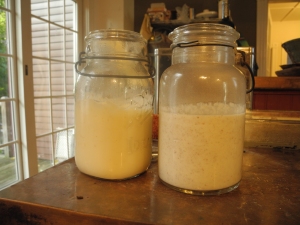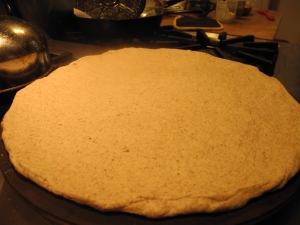Bechamel, a.k.a. the all-purpose white sauce
Before I begin, I want to start by defending wheat and dairy, which are all that a bechamel sauce is. I believe that wheat and other grasses are, unless you suffer from celiac disease, a reasonable and important part of a well-rounded, economic, long-view diet. It should not comprise the bulk of any diet but if using fresh whole grains and cooking from scratch as much as possible it is a great way to vary a diet, stretch a dollar, and reinvent leftovers. And in terms of a long-view of our food system, I’m convinced that wheat and other grasses will have to play a part in feeding everyone on the planet an adequate diet. Every food has its pitfalls, but what if most of the pitfalls we are seeing around gluten today are a result of over-consuming over-processed wheat? Check out the foodbook Nourishing Traditions or the Weston A. Price Foundation for some suggestions and recipes on “culturing” wheat before using.
Dairy has been similarly maligned, and again I suspect it’s because of the over-consumption of poor quality dairy products. Try including a small quantity of high-value products in your diet sometime! It’s a brilliant way to extend the life of milk (thereby supporting small farmers seeking to add value to a highly perishable product), it’s a way to add richness, flavor, and protein to vegetable-based dishes, and cultured dairy products such as yogurt and kefir offer a load of healthful gut flora to our systems.
Alright, I’m off my soapbox and on to the actual topic of this post!
Bechamel sauce is the workhouse of my kitchen. And a touch of maple syrup goes a long way to giving the flavor of the sauce a bit of depth. Traditionally the sauce is made with white flour. But whole wheat flour and maple syrup have already been proven to go well hand in hand, and there is definitely a place for a heartier and more robust sauce in certain dishes.
Bechamel can be the base for a white pasta or pizza sauce. It can be a thickener for soups or stews. It can be a filler for casseroles, scalloped vegetable dishes and gratins, or pot pies. It can be the foundation for gravies and other toppers. Given its versatility, I knew I needed to better understand it. So I undertook another maple syrup-and-flour experiment: making a white flour bechamel and a whole wheat bechamel, and trying them each in two different dishes. I opted to try out the bechamel sauces on pizza and in pasta.
Bechamel is based on the foundation of melted butter with flour cooked in, also called a roux. Cooking the butter and flour together for certain lengths of time will change the flavor, appearance, and texture of the bechamel. Even with white flour, if the butter is browned and the roux cooks for several minutes it will become browner and nuttier in flavor. Or the roux can be left almost perfectly white if cooking only briefly after combining. Then the warm milk needs to be added slowly with constant stirring. Different percentages of milk will also change the bechamel. I only ever use heavy cream, half and half, and whole milk in my kitchen, but I would imagine that a thinner, lighter bechamel would result from using 2%, 1% or nonfat milk.
I started with a basic bechamel from Smitten Kitchen (because I was making a lasagna and I adore her lasgana post) that uses 1/2c flour and 1/2c butter, then 3 cups of whole milk and 1 of heavy cream. This produces enough sauce for one pizza and one 2 quart soup, two pizzas, or a large lasagna. I found that the white flour bechamel was thicker than the whole wheat bechamel. When I ran out of cream and used only milk, both were on the thin side. I prefer a thicker bechamel – it is always easier to thin something out eventually than to thicken it back up (plus maple syrup is another liquid that is getting added in), so I also decided to make up a bechamel with double the amount of flour to butter. Traditionally, a roux is equal parts weight of flour and butter rather than equal volumes of flour and butter. By this measure I would use 1/2c butter to 1c flour. So I did, and then I seasoned to taste with se salt, freshly ground nutmeg, and maple syrup.

Bechamels made up, I worked on the pizza dough. Incidentally, I had some lovely freshly ground whole wheat flour from the Grist Mill project here in central Maine that I was testing out – it made awesome dough. I’m starting to think Paul Bertolli is right about freshly gound flour being the single most important element for great dough. My preferred dough recipe is from Michael Ruhlman’s Ratio: 20oz flour (10 each of white and whole wheat), 12c warm water, 1/2 tsp dry yeast, 2 tsp salt, 1 T olive oil. This makes up enough dough for two pizzas. Each pizza was half white flour bechamel and half whole wheat flour bechamel. One had pumpkin, herbs, and grated pecorino and the other had apples, caramelized onions, tofu, and grated pecorino. Hands down Travis and I both preferred the whole wheat bechamel. Pizza dough, even great pizza dough, is bland. The white flour bechamel didn’t offer the same quality of depth and flavor that the whole wheat bechamel did. So that was an easy choice.
Next dish: baked pasta. The lasagna was probably not as great as Smitten Kitchen’s, the whole wheat dough and the tomato basil pasta sauce both being purchased at the store, but it was tasty. I used the white flour bechamel and it offered the right texture and creaminess to balance the acidity and zip of the tomato sauce, but not really anything on the flavor front.
Rather than create another lasagna (which would have been great but I was hosting an apple themed party today) I baked up an apple mac n’cheese. I made two baked pastas for the party, one with a thinner whole wheat bechamel and the other with a thicker whole wheat bechamel (and before you tell me that I was not as scientific as I could have been I will pre-empt you and explain that I am not the queen of science and I have a budget, a schedule, and a two-year old to contend with — this “experiment” should perhaps be called an exploration!).
Both were tasty and after baking the apples, the onions, the colby cheese, the sauce and the whole wheat noodles all together, there was no noticeable difference between the thicker bechamel and thinner bechamel. But the flavor of the whole dish was really good.
So at the end of all this exploring, here are some conclusions:
1. whole wheat bechamel has more flavor than white flour bechamel;
2. white flour bechamel vs. whole wheat flour bechamel in a sauce needs to be further explored based on the assumption that texture matters more here and the textures of the two sauces are very different;
3. whole wheat flour bechamel is probably better than white flour bechamel for a soup based on the assumption that the flavor is the critical factor and we’ve established the superiority of the flavor of whole wheat bechamel;
4. whole wheat flour bechamel is absolutely the best choice for pizzas and baked casserole and pasta dishes;
5. heavy cream is a good idea (this is simply a true statement regardless of the context); and
6. this is sort of an aside, but freshly ground whole wheat flour is quite awesome and will surely become a staple in my kitchen.
Next week, some revealing details about my food politics as I explore arrowroot powder vs. cornstarch vs. tapioca in maple pudding…


I, too, would like to have giant jars of bechamel! Is a bit of sweetening typical for bechamels, or is the addition of sweetness (a bit of maple syrup here, of course!) your particular addition? It’s sounds very decadent, and I can’t wait to try it. Now that the weather has (finally) turned cool down here, I’ve had my eye on more than a few baked pastas! Thanks for sharing this experiment!
It’s my addition, you know me, I stick maple syrup in everything. But I do think nutmeg, which is very typical in bechamel, is reminiscent of sweetness with all its warm spice glory. I’ve definitely used too much maple in it, and I don’t recommend it in every bechamel application — but creamed spinach was especially awesome and it was darn good in chicken pot pie!
This is awesome. I make bechamel whenever I make mac and cheese. I will totally try out whole wheat flour next time!
ps… miss you guys!